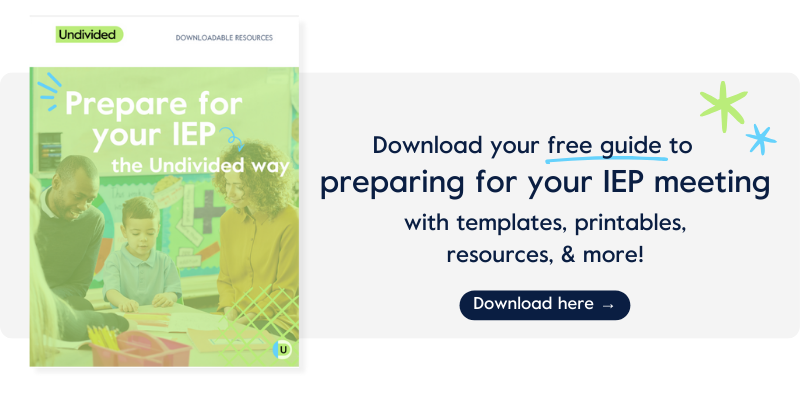What Is an IEP? IEP 101
An Individualized Education Program, or IEP, is central to any family’s experience of special education. The IEP meeting is where you will meet with your school team and build a plan for your child’s special education goals and services, which — true to the “individualized” in its name — should be tailored to your child’s unique needs. The plan becomes a legal agreement between you and your school that must be followed.
Definition of an IEP in special education
An IEP outlines services and supports that the school or district will provide, at no cost to the student’s family, to ensure that the student has access to a Free and Appropriate Public Education (FAPE) under the Individuals with Disabilities Education Act (IDEA), and that their individual needs are met. Every child who receives special education services must have an IEP.
In the clip below, Undivided's Education Advocate Lisa Carey provides a brief explanation of this important document:
Who is eligible for an IEP?
A child is eligible for an IEP if they meet the criteria for one of thirteen eligibility categories and if they cannot make adequate progress in school without special education services. Here's a breakdown of each category.
If a student is not eligible for an IEP, they may still qualify for a 504 plan. (Learn more about the differences between a 504 plan and an IEP here.)
Who writes an IEP?
How are students assessed for an IEP?
In order to qualify for an IEP, a student must receive an initial full assessment. A full assessment is a multidisciplinary set of assessments conducted by a school psychologist, special education teacher, and any additional related service providers who are relevant to the student’s disability — these can include speech, occupational, behavioral, vision, and physical therapists, and more. A parent can request an assessment of their child at any time. (Here is a sample letter that Undivided members can use to request an assessment for an IEP.)
If a student qualifies for special education services, a full reassessment must be conducted every three years (called a triennial assessment) to ensure that they still qualify for special education services. A child’s IEP must also be reviewed once a year at minimum to determine whether the annual goals are being achieved or must be revised. Read more about the types of assessments conducted for IEPs.
Request an educational assessment
When is the IEP developed?
What are the components of an IEP?
An IEP includes the following:
- Parent concerns (consider writing a parental concerns letter)
- Student strengths (read about how to develop a strength-based IEP!)
- Goal review (learn how to write IEP goals)
- Present levels of performance, or PLOP
- Progress reporting
- Annual goals and short-term objectives
- Special education and related services
- Supplementary aids and services, also known as accommodations and modifications (see our list of accommodations for IEPs and 504s here)
- Extent of non-participation in general education, which also means defining the least restrictive environment (LRE) for your child
- Statewide assessments
- Service delivery (offer of FAPE), which often includes placement
We break all of these down in our article on key parts of an IEP.
What is a strength-based IEP?
A strength-based IEP prioritizes a child’s strengths by focusing on and utilizing the skills they already have rather than focusing on their deficits. This helps educators develop appropriately challenging goals and objectives in their curriculum, and ensures that the services and supports provided for your child will work to actively enhance skills and eliminate barriers to learning.
Learn how to build an IEP from your child’s strengths. You can begin the process by writing a vision statement to share with the IEP team.
How do I prepare for an IEP meeting?
First, make sure you’ve got all the essential documents you will need at the meeting – review this IEP meeting checklist. Here are several more tips to help you get ready for the IEP meeting.
How do I review the IEP?
What if I disagree with the IEP?
How do I make sure the IEP is being followed?
Ensure my child's Individualized Education Program (IEP) is being followed
Join for free
Save your favorite resources and access a custom Roadmap.
Get StartedAuthor



